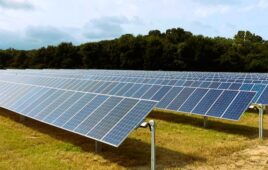Legislation was introduced in both the House and Senate this week to encourage the development of energy storage systems in the United States. In the House, Congressman Bill Foster (D-IL) introduced the Better Energy Storage Technology (BEST) Act of 2019, co-sponsored by Congresswoman Jaime Herrera Beutler (R-WA), Congressman Sean Casten (D-IL), and Congressman Anthony Gonzalez (R-OH). Senators Susan Collins (R-ME), Martin Heinrich (D-NM), Cory Gardner (R-CO), Tina Smith (D-MN), Chris Coons (D-DE), Martha McSally (R-AZ) and Angus King (I-ME) introduced a companion BEST Act in the Senate.
The bipartisan legislation aims to support grid-scale energy storage R&D and improve the efficiency of the nation’s electric grid, while helping to align research efforts on energy storage technologies.
“Next generation energy storage devices will help enhance the efficiency and reliability of our electric grid, reduce energy costs, and promote the adoption of renewable resources,” said Senator Collins. “Our bipartisan legislation would help catalyze the development of this technology that holds great promise in the fight against climate change by supporting clean energy generation, including wind and solar.”
“If enacted, the BEST Act will authorize the Department of Energy to undertake new public-private partnerships for proving promising electrochemical, thermal, and physical storage technologies in actual electric grid operations. Doing so will ensure a fuller range of storage options is available to meet the needs of a 21st century electric system,” said Energy Storage Association CEO Kelly Speakes-Backman.
The BEST Act legislation aims to increase the affordability of this technology by directing the DOE to pursue a strategic plan and implement cost targets.
Specifically, the BEST Act:
- Focuses grid-scale energy storage research and development on:
- Highly flexible power systems with a minimum duration of six hours and with a lifetime of at least 8,000 cycles of discharge at full output and 20 years of operation;
- Long duration storage systems with power output of 10 to roughly 100 hours, with a lifetime of at least 1,500 cycles and 20 years of operations;
- Seasonal storage systems that can store energy over several months and address seasonality concerns.
- Supports up to five demonstration projects to advance commercialization of grid-scale energy storage technologies.
- Directs DOE to develop a strategic plan and cost targets for grid-scale energy storage.
- Accelerates testing and validation of energy storage systems through the country’s National Laboratories.
- Requires coordination and alignment of research efforts to produce commercially viable energy storage systems through coordination at DOE, National Laboratories, federal agencies, and end users.
- Authorizes $60 million annually for the program from 2020 to 2024.




From the article: “Focuses grid-scale energy storage research and development on:
Highly flexible power systems with a minimum duration of six hours and with a lifetime of at least 8,000 cycles of discharge at full output and 20 years of operation;
Long duration storage systems with power output of 10 to roughly 100 hours, with a lifetime of at least 1,500 cycles and 20 years of operations;
Seasonal storage systems that can store energy over several months and address seasonality concerns.”
The last two goals of storage systems that can output 10 to roughly 100 hours can be achieved by using some sort of redox flow battery technology. The redox flow storage would be defined by two major system components. The number of cells that would actually become a series/parallel power buss that would be inverted to A.C. the actual MWh of generation and the size of the ion storage tanks used to feed the cells. Very large ion storage tanks over several acres could feed the cells and inverter(s) from several hours to several days. Making such systems into generation/storage blocks would enable storing some power from one grid connection, while switching power to service another grid connection at a major switching station where two, three, maybe even four high voltage service lines enter the station to be switched as needs arise.
Energy storage has gotten a black eye, since the fire and explosion of the Surprise AZ, McMicken energy storage facility 4/19/2019. An inquiry is under way and no ‘public’ report has been released as of yet. Many questions will need to be answered there. It is apparent that the battery banks failed at some point in the battery array. There was temperature control on the building, did it fail? There is an antenna on the building, what happened to alarms sent to a ‘control center’, did the telemetry fail? TESLA set the pace and Battery management systems are common place for large energy storage systems, what happened to this system’s BMS? The actual battery chemistry, is it high density Li, Co, O or Li, Co, Mg, O chemistry or was it the “more stable” LiFePO4 chemistry? Perhaps it’s time for the so called solid state battery technologies to be quickly developed. Getting rid of volatile electrolytes would go a long way in making energy storage safer and longer lasting.